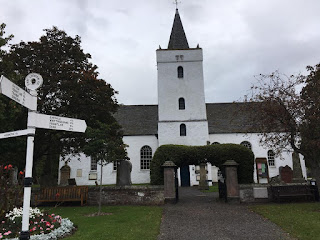Rough
winds do shake the darling buds of May.*
No
doubt about that as the gales buffet the fruit trees creating a
snowstorm of apple blossom. Our hopes for a huge crop of apples to
puree and freeze or trade with the cider maker for a share of last
year's output is diminishing with every blast. The plums may have
suffered the same fate though they were further advanced and the gean
tree has shed a
load
of nascent bird cherries.
What will the blackies and fieldfares do
come Autumn and what of the wood mouse who lives in the hedge and
whose winter stores of cherry stones I find, each opened like a can
of beans to get the kernels
?
May
is a spectacularly variable month for weather, scorching sunshine
then squalls of rain and wind to follow within a day. No sooner have
we got the sun-lounger out than we are putting it away before it
tumbles in the wind like a huge daddy-long-legs across the grass.
Ne'er
cast a cloot 'til (the) may is oot.
**
Last
week with its scorching days, proved this a truism as the may blossom
burst forth in frothy splendour with their their strange musky sweet
scent heavy in the hot sun then, capricious as ever the wind blew in
from the North and changed the adage to its commoner interpretation -
ne'er cast a cloot 'til May is oot.
The
Merry month of May
The
merriest month in all the year is the merry month of May***
A
time for courting or "winching" as the Scots would have it,
a time for the maypole with its significance, a time for May queens,
a time when the may and May become fused into one great celebration
of love and fertility.
Near
us is the village of Polwarth, remembered in verse by Alan Ramsay in
his Polwarth on the Green.
At
Polwart on the green
If
you’ll meet me on the morn
Where
lasses do conveen
To
dance around the thorn
There
was a tradition of newly-weds out walk around the hawthorn tree
presumably a folk memory of an old fertility rite. Fortunately, the
tree still survives and a descendant tree has been grown along side
its ancient sire.
 |
| The Polwarth Thorn |
Young
love, fertility symbolism, the queens of the May, the green man,
dancing round the may pole.
No
wonder that May is the merriest month.
Here
we come gathering nuts in May
Nuts
in May
On
a cold and frosty morning
Yes
there are some cold and frosty mornings in May but nuts? There
aren't ever nuts in May. It would seem it's really "knots"
in May. Knots or bouquets of may flowers
collected as part of a children's game pairing boys and girls, an
echo of an older custom of choosing a spouse and so we come round
again to May being the merriest of the months!
 |
| Knots of may |
...and now we make do with a bank holiday!
* W.S.
** Anon
*** Ballad



































